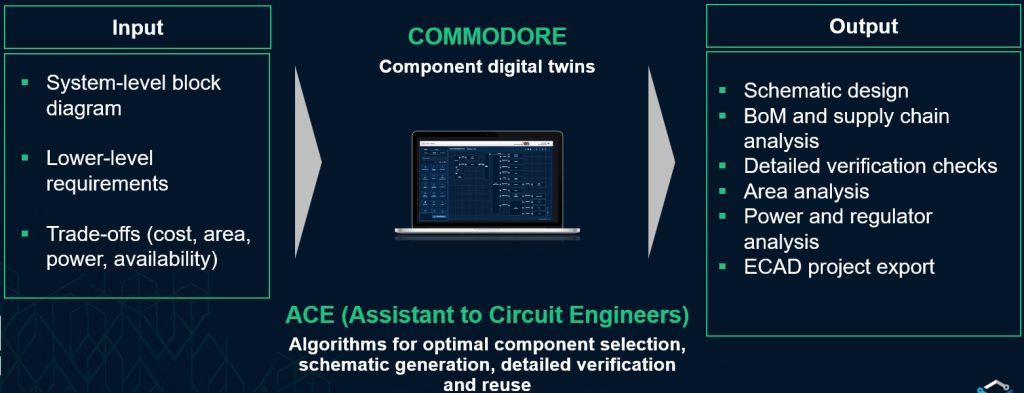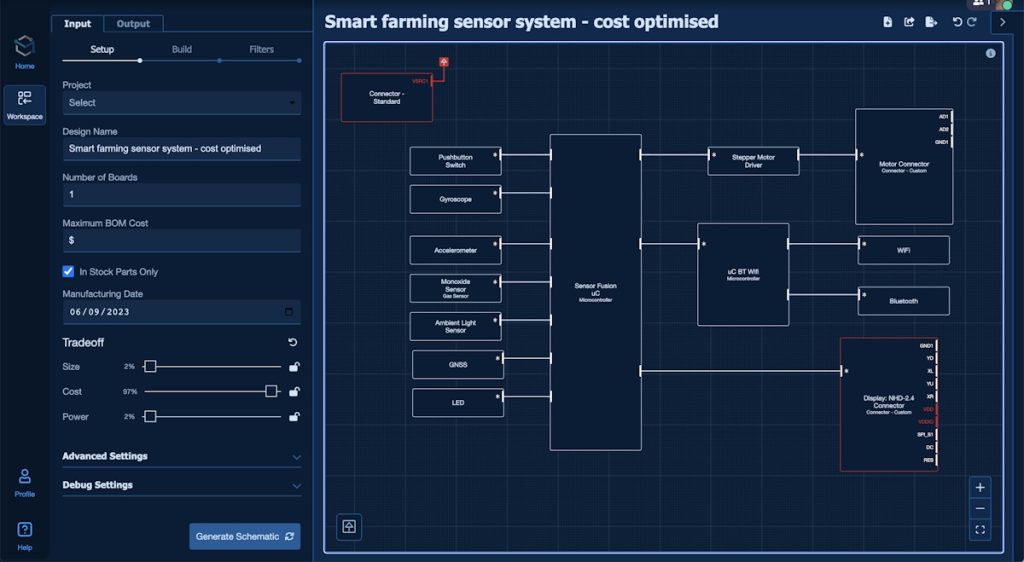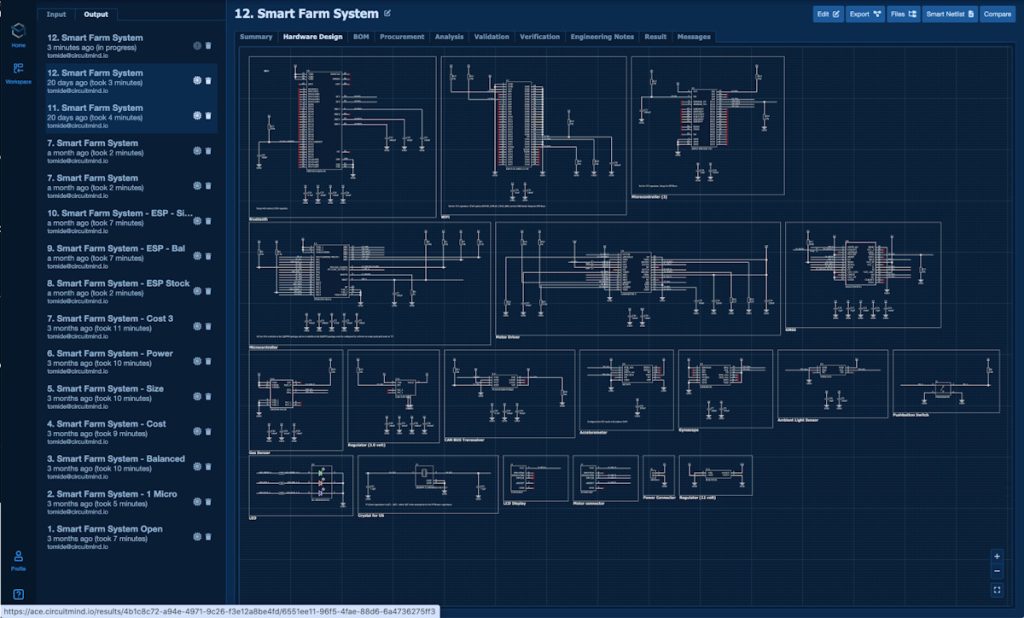Are you ready to meet the world’s first deterministic AI that helps electronic teams go from architecture to schematic in 60 seconds? We’re talking about algorithmic component selection and schematic generation technology that optimizes billions of component combinations, thereby allowing you to avoid datasheet doom-scrolling, reduce schematic errors, and design for supply chain resilience in minutes. What’s not to love?
Before we plunge into the fray with gusto and abandon (and aplomb, of course), I’m extremely excited to tell you that what I’m about to tell you has not been told publicly before. Having said this, the technology I’m poised to unveil has been shared with a few advanced users, who are wildly enthusiastic because they are currently enjoying a competitive advantage that will soon be available to all.
Before we proceed further, if your interest is piqued by what you peruse here, the formal grand unveiling in the form of an online public demonstration is set to take place on Thursday 29 February 2024 at 11:00 am Central Time in the US and Canada (which is GMT –6 hours). The point is that it would be a great idea to register now to get one of the good virtual seats while the getting is good. This way, the folks at Circuit Mind will be able to email you to remind you close to the day of divulgement and discovery.
These days, we are used to having a world of information at our fingertips. In the case of electronic engineers, for example, in addition to looking at images of cats, we can use the interweb to track down and access data sheets in a matter of seconds. The amazing thing to me is that many younger engineers have no idea how things were in the not-so-distant past.
From when I started my career until sometime circa the mid-1990s, we design engineers had to fend for ourselves. I know the internet first impinged on the public’s perception in 1993 with the introduction of the Mosaic web browser, but there really wasn’t much useful information available out there for quite a few years. Thus, engineers would maintain their own collections of data books in their offices. Companies allocated small annual allowances to purchase data books and subscribe to trade publications. It might be that your company also had its own small library but—if so—they rarely had what you were looking for. If you couldn’t find what you needed, you either asked a component vendor’s local representative to pay you a visit or you requested the requisite information, often by post. It could take weeks before the data book or data sheet in question arrived, only for you to discover that you were looking at the wrong component (i.e., one that wasn’t suited to your needs). I have no idea what the procurement folks had to go through when they finally got to see a design featuring components that were in short supply or had gone end-of-life while no one was looking. Well, actually, I do have some idea, but I prefer not to think about it.
The reason all this came to my mind is that I was just chatting with Tomide Adesanmi, who is the Co-Founder and CEO at Circuit Mind. This is a small company that is bulging with brainy boffins—you can’t swing a stick without hitting a PhD or a university professor, so it’s lucky they have so many to spare.
I think the best way to explain this is by means of a few well-chosen graphics and screenshots. In a crunchy nutshell, as illustrated below, we start by defining an architecture as a system-level block diagram (we’ll see an example of this in a moment). For each block we can specify lower-level requirements, like the size of a memory, for example. We also use slider controls to specify the tradeoffs in which we are interested (cost, area, power, availability).

High-level view of the Circuit Mind flow (Source: Circuit Mind)
There are two key items “under the hood,” as it were. First, we have COMMODORE, which is a library of digital twins for components. Anything you can read in a data sheet is captured as part of the digital model. Next, we have Assistant to Circuit Engineers (ACE). This little scamp looks at your system-level block diagram, accesses any appropriate digital twins, considers, compares, and contrasts billions of component combinations, and outputs a schematic that meets your design goals and tradeoffs. Just to add a great big dollop of metaphorical cream on top of the allegorical cake, ACE also generates a BOM and supply chain analysis, area analysis, power and regulator analysis, and it performs detailed verification checks. The schematic can subsequently be fed to a PCB layout tool from the vendor of your choice.
Let’s take a slightly closer look. Consider the system-level block diagram shown below. This was created by dragging and dropping functional blocks from the library and then adding links to show what is connected to what. You can specify as little or as much additional information as you wish, from vague requirements like 1, 2, or 3 axes on an accelerometer to a specific family of devices or a more specific part number. Similarly, in the case of a microcontroller, you can leave ACE unfettered to choose anything it wants, or you can pick a data bus size (8-bit, 16-bit, 32-bit) and/or a manufacturer and/or a family… all the way down to a particular part and package.

Capturing a system-level block diagram (Source: Circuit Mind)
The real magic occurs once you’ve specified your desired tradeoffs and you click the “Go” button. In a matter of moments, you are presented with a schematic in the form shown below.

The automatically generated schematic (Source: Circuit Mind)
I know that nitty-gritty details are a little hard to see in this compressed image—you’ll just have to trust me that ACE has added any required pull-up and pull-down resistors, decoupling capacitors, level-translators, etc.
Of particular interest is that, as soon as you’ve kicked one run off, you can tweak your tradeoffs and set another run running, if you see what I mean. In fact, during my private demonstration, Tomide kicked off a whole bunch of runs so we could compare the outputs.
So, who might use this sort of tool? Is this a toy intended only for hobbyists, or is it targeted at a more professional audience? I know a lot of hardware design engineers who believe in their hearts and souls that no computer algorithm can conceive something better than they. I remember software developers saying the same thing about their cunningly crafted assembly-level code when higher-level languages like C and associated compilers entered the fray. One of the main advantages of moving to a higher level of abstraction is that this allows you to quickly and easily explore more of the solution space associated with your project. Suffice it to say that assembly-level programmers aren’t as thick on the ground as they used to be.
As Tomide pointed out, it’s often the case that a design service or Electronic Manufacturing Services (EMS) company is presented with a Request for Quote (RFQ). They haven’t won the design yet, but the customer says something along the lines: “I want to choose the vendor that can give me the lowest BOM cost.” Using Circuit Mind, once you’ve captured your system-level block diagram architecture, you can determine the projected BOM cost before you’ve finished quaffing a cup of coffee (quaffing is much like drinking except you tend to spill more down your chest… as I know, to my cost).
Now, I don’t know about you, but—when it comes to Electronic Design Automation (EDA) and Electronic System Level (ESL) tools—I’ve often been beguiled with promises of delectation and delight, only to have my hopes cruelly crushed. In order to quell any questions we might raise, Tomide has kindly created the following FAQ:
#1: What does the Circuit Mind platform do?
ACE allows an engineer to input their requirements as a functional block diagram, specify their detailed design intent on each block, and, with a single click, generate cost-effective, power efficient, small form factor schematic and BoM options in 60 seconds. It also optimizes for lifecycle status, supply chain resilience, preferred manufacturers, and more.
#2: What problems can Circuit Mind solve for me?
Develop better circuits by exploring multiple solutions optimized for performance, cost, size, power and other constraints. Accelerate time to market by performing component selection and schematic generation in minutes. Prevent respins with design for availability and supply chain, and also prevent respins with automated verification checks.
#3: Who is the Circuit Mind platform for (Makers, Hobbyists, Early career, Mid-career, Late career)?
The platform is primarily for professional electronic engineers in any stage of their career. The average user of the platform has 7 years of experience.
#4: Does Circuit Mind use AI?
Our circuit design generation uses deterministic algorithms. These algorithms are built on solid fundamental circuit design principles crafted to operate alongside an engineer as a trustworthy source of options, results, and outcomes. No statistical guesses and no hallucinations. However, in order to create our electronic component digital twin models, we do use machine learning (ML) and large language model (LLM) algorithms with rigorous human supervision to ensure accuracy.
#5: Has the Circuit Mind platform been used on real, professional designs?
Yes. Our customers are primarily professional electronics engineers and managers who are using the Circuit Mind platform on real-world designs in the following industries: Design Services, EMS, Industrial, Medical, Automotive, Consumer.
#6: Is Circuit Mind taking away the jobs of electronic engineers?
No. The platform is designed to be a trustworthy, reliable partner for electronic engineers. You are in control, and you still need to solve the toughest problems that require human creativity.
#7: Does the Circuit Mind platform work with my current ECAD tools?
Yes. The platform exports project files (schematics, symbols, and sometimes footprints) to ECAD tools such as Altium Designer, Orcad, DipTrace, and more. We add new formats based on customer requests. We can also plug into a customer’s own libraries.
#8: Sometimes I know the components I need; can I specify those in the Circuit Mind platform?
Yes. You can leave functional blocks open or specify lower-level requirements on each block to the level of specificity you want. You can even specify the part number directly and the platform does the rest for you.
#9: Does the Circuit Mind platform help me with layout?
No. The platform is focused on helping electronics teams with the front-end of their design process: architecture, component selection, schematic capture, and schematic verification.
#10: Is this platform just storing and sharing pre-created reference designs?
No.
#11: How can I start on the Circuit Mind platform?
You can visit https://www.circuitmind.io/and book a demo. We’ll start by discussing your use cases, and then we’ll give you a hands-on experience of the platform.
I don’t know about you, but I had to laugh when I read the answer to question #10, which was short, sharp, and to the point. So, what do you think about all this? While you are pondering what to write in the comments below, may I remind you to register for the official launch demo, which will commence at 11:00 am Central USA Time on Thursday 29 February 2024 (this will allow the guys and gals at Circuit Mind to send you a reminder close to the event).






“This is a small company that is bulging with brainy boffins—you can’t swing a stick without hitting a PhD or a university professor, so it’s lucky they have so many to spare.”
Sticks (or Phd’s/professors)?
Phd’s/professors — you have to bring your own stick.